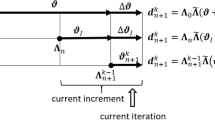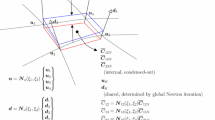Abstract
We compare three nearly optimal quadrilateral finite elements for geometrically exact inextensible-director shell model. Two of them are revisited and one is novel. The assumed natural strain (ANS) element of Ko et al. (Comput Struct 185:1–14, 2017) shows low sensitivity to mesh distortion and excellent convergence behavior for most types of shell problems. The Hu–Washizu element with ANS shear strains of Wagner and Gruttmann (Int J Numer Methods Eng, 64:635–666, 2005) allows for large solution steps and is computationally fast. However, both formulations have undesirable weak spots, which we clearly identify by a comprehensive set of numerical examples. We show that a straightforward combination of both formulations results in a novel element that synergizes the positive features and eliminates the weak spots of its predecessors.



















Similar content being viewed by others
References
Bathe KJ (2014) Finite element procedures, 2 edn. K.J. Bathe, Watertown, MA
Brank B, Ibrahimbegovic A (2001) On the relation between different parametrizations of finite rotations for shells. Eng Comput 18:950–973
Brank B, Perić D, Damjanić FB (1997) On large deformations of thin elasto-plastic shells: Implementation of a finite rotation model for quadrilateral shell element. Int J Numer Methods Eng 40:689–726
Choi CK, Paik JG (1996) An effective four node degenerated shell element for geometrically nonlinear analysis. Thin-Walled Struct 24(3):261–283
Crisfield MA (1996) Non-linear finite element analysis of solids and structures, volume 2: advanced topics. Wiley, Hoboken
Dujc J, Brank B (2012) Stress resultant plasticity for shells revisited. Comput Methods Appl Mech Eng 247:146–165
Dvorkin EN, Bathe KJ (1984) A continuum mechanics based four-node shell element for general nonlinear analysis. Eng Comput 1:77–88
Goto Y, Watanabe Y, Kasugai T, Obata M (1992) Elastic buckling phenomenon applicable to deployable rings. Int J Solids Struct 29(7):893–909
Gruttmann F, Wagner W (2005) A linear quadrilateral shell element with fast stiffness computation. Comput Methods Appl Mech Eng 194:4279–4300
Gruttmann F, Wagner W (2006) Structural analysis of composite laminates using a mixed hybrid shell element. Comput Mech 37:479–497
Ibrahimbegović A, Brank B, Courtois P (2001) Stress resultant geometrically exact form of classical shell model and vector-like parameterization of constrained finite rotations. Int J Numer Methods Eng 52(11):1235–1252
Ibrahimbegović A (2009) Nonlinear solid mechanics. Springer, Dordrecht
Ko Y, Lee PS, Bathe KJ (2017) A new MITC4+ shell element. Comput Struct 182:404–418
Ko Y, Lee PS, Bathe KJ (2017) The MITC4+ shell element in geometric nonlinear analysis. Comput Struct 185:1–14
Ko Y, Lee Y, Lee PS, Bathe KJ (2017) Performance of the MITC3+ and MITC4+ shell elements in widely-used benchmark problems. Comput Struct 193:187–206
Korelc J, Wriggers P (2016) Automation of finite element methods. Springer, Berlin
Kulikov GM, Plotnikova SV (2010) A family of ANS four-node exact geometry shell elements in general convected curvilinear coordinates. Int J Numer Methods Eng 83(10):1376–1406
Magisano D, Leonetti L, Garcea G (2017) Advantages of the mixed format in geometrically nonlinear analysis of beams and shells using solid finite elements. Int J Numer Methods Eng 109:1237–1262
Oesterle B, Sachse R, Ramm E, Bischoff M (2017) Hierarchic isogeometric large rotation shell elements including linearized transverse shear parametrization. Comput Methods Appl Mech Eng 321:383–405
Pian THH, Sumihara K (1984) Rational approach for assumed stress finite elements. Int J Numer Methods Eng 20(9):1685–1695
Simo JC, Armero F (1992) Geometrically non-linear enhanced strain mixed methods and the method of incompatible modes. Int J Numer Methods Eng 33(7):1413–1449
Simo JC, Fox DD (1989) On a stress resultant geometrically exact shell model. Part I: formulation and optimal parametrization. Comput Methods Appl Mech Eng 72:267–304
Simo JC, Fox DD, Rifai MS (1990) On a stress resultant geometrically exact shell model. Part III: computational aspects of the nonlinear theory. Comput Methods Appl Mech Eng 79:21–70
Simo JC, Hughes TJR (1986) On the variational foundations of assumed strain methods. J Appl Mech 53(1):51–54
Wagner W, Gruttmann F (2005) A robust non-linear mixed hybrid quadrilateral shell element. Int J Numer Methods Eng 64:635–666
Wiśniewski K (2010) Finite rotation shells, basic equations and finite elements for Reissner kinematics. Springer, Dordrecht
Wisniewski K, Turska E (2009) Improved 4-node Hu–Washizu elements based on skew coordinates. Comput Struct 87:407–424
Wisniewski K, Wagner W, Turska E, Gruttmann F (2010) Four-node Hu–Washizu elements based on skew coordinates and contravariant assumed strain. Comput Struct 88:1278–1284
Wriggers P (2008) Nonlinear finite element methods. Springer, New York
Yu G, Xie X, Carstensen C (2011) Uniform convergence and a posteriori error estimation for assumed stress hybrid finite element methods. Comput Methods Appl Mech Eng 200:2421–2433
Author information
Authors and Affiliations
Corresponding author
Additional information
Publisher's Note
Springer Nature remains neutral with regard to jurisdictional claims in published maps and institutional affiliations.
Rights and permissions
About this article
Cite this article
Lavrenčič, M., Brank, B. Hybrid-mixed shell quadrilateral that allows for large solution steps and is low-sensitive to mesh distortion. Comput Mech 65, 177–192 (2020). https://doi.org/10.1007/s00466-019-01759-3
Received:
Accepted:
Published:
Issue Date:
DOI: https://doi.org/10.1007/s00466-019-01759-3




